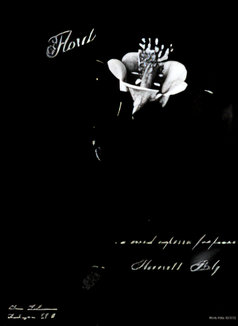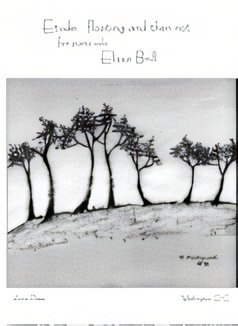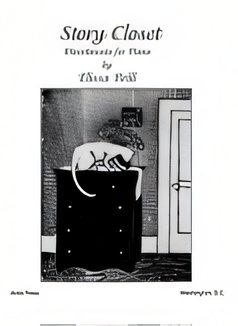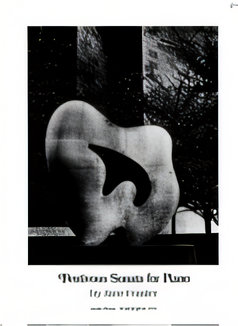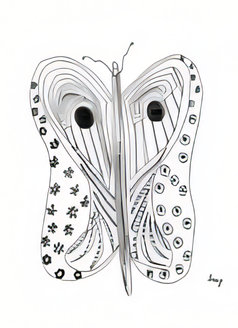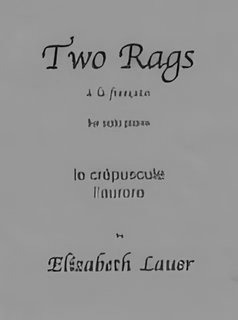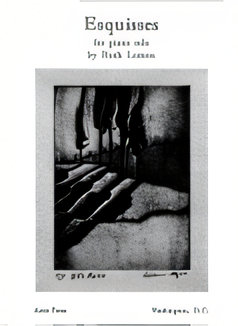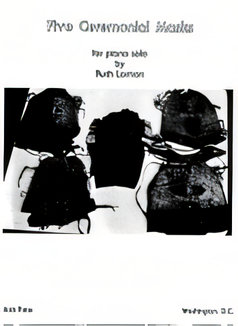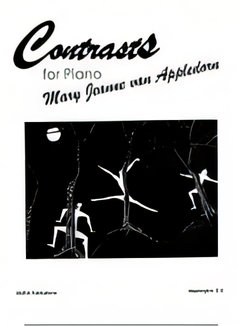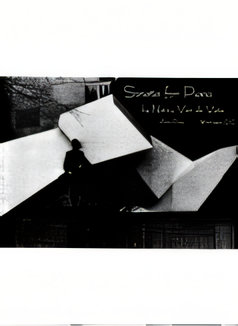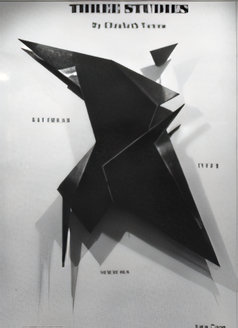Solo Piano
Bolz, Harriet
Floret-A Mood Caprice for Piano
Marked Allegretto, this one-movement piece contains a repeated, one-measure LH pattern at the beginning that recurs near the end with a different melodic part in the RH along with some demanding octave passages in the central sections.
Two Profiles for Piano
Compositions of elegant simplicity, contemporary and lyrical. The first profile is marked Simple, graceful and the second is Gay, debonair.Brill, Elissa
Etude: floating and then not
The composer writes: “Etude grew out of a conversation I had with a colleague. We were contemplating what it is about some pieces of music that makes them feel like they are floating on air, and what it is about some other pieces that makes them seem to be so close to the earth. Although there are many other elements at work, one important element seemed to be the nature of the rhythmic resolution. It is the treatment of rhythm that I chose to explore in this piece. The form is ABA, where each A section is mostly floating and the B section is mostly not.”
The score is available from J.W. Pepper.
Story Closet-divertimento for piano
The piece was written in 1986 in five movements: Opening Music, Tennis Racket/Unstrung, Wool Blazer/Circa 1978, Useless Gift, Costume Jewelry. The composer describes her piece as “short sketches of found memories, a light-hearted travelogue through fond childhood thoughts.”
The score is available at the Sibley Music Library at the Eastman School of Music.
Brockman, Jane
Character Sketches for piano
“most accomplished…fascinating… an aural Rorschach, with side trips ” (Los Angeles Times)
Stylistic ‘characters’ from the music of Debussy, Schoenberg, Wagner and Mussorgsky serve as a point of departure in these three movements. Sometimes the references appear in the form of quotations, other references are simply evocative. The strategy for this work was to uncover the similarities and relationships among these different characters–and to guide their evolution still further into materials which are mine alone. The listener can identify three bell-theme quotations from Wagner’s Parsifal, Schoenberg’s Sechs Kleine Klavierstucke, and Mussorgsky’s Boris Godunov. These unify the three movements. The piece is recorded on a Leonarda compact disc by Nanette Kaplan Solomon. (Notes by the composer.)
The music is available from the composer’s website.
Tell-Tale Fantasy for piano
“Her Tell-Tale Fantasy is a piece with subtle musical quotations-paraphrased allusions to Scriabin, Schoenberg, Ives and Debussy–intended to invoke the impression of a pianist, performing a highly contemporary piece of music, who daydreams and drifts occasionally into wistful thoughts about masterworks of the early twentieth century. . . impressive.” (Fanfare)
Although the notation is precise, this short piece is designed to create an illusion of improvisation. At each digression, there are brief paraphrases of works by Scriabin (Prometheus Symphony), Schönberg (Opus 19 and Opus 16), Ives (Concord Sonata) and Debussy (Dr. Gradus Ad Parnassum).
The music is available from the composer’s website.
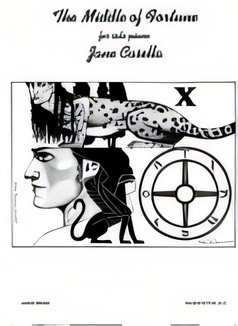
Casella, Jane
The Middle of Fortune for piano
Ms. Casella has experimented with a variety of styles among which The Middle of Fortune emerges as one of her most appealing compositions.
The score is available from AbeBooks.
Diemer, Emma Lou
Encore for Piano
“A strongly melodic piece, Encore is both accessible and enjoyable.” (Indiana Gazette)
Encore was written in 1981 for Diemer’s colleague at the University of California at Santa Barbara, pianist Betty Oberacker. The piece is virtuosic and technically demanding, concerned more with short motives than with extended melodic development. It has been widely performed and is available on a Vienna Modern Masters compact disc.
The score circulates in many librairies.
Toccata for Piano
Repertoire of the Seventeen National Piano Competition
“Emma Lou Diemer’s Toccata is as unpredictable as it is fun and pleasing. . . a pianistic adventure” (Fanfare)
“There was a sense of tonality in Miss Diemer’s Toccata and a sense of theater that was very striking indeed.” (Charleston News & Courier)
Written in 1979 for one of her students at the University of California, the Toccata combines traditional piano writing with “neo-Cowell effects” (such as hand-dampening the strings and performing directly on the strings) that are used in fresh ways to create a “rambunctious pianistic adventure” (Fanfare). The piece is also described as having “driving rhythm” and as being “infused with a real musical personality” (Charleston News & Courier). A review in the Chico News and Review described the piece as follows. “Diemer’s Toccata was filled with wonderful ‘in-the-piano’ effects–hand-dampened strings, string-stroked arpeggios, block-like, Messiaen-styled chord echoes.”
The score is available in an anthology called Music Without Borders.
Frasier, Jane
Festivous Sonata for Piano
“distinctive sound and logical structure that satisfied to the last chord” (Keyboard)
The Sonata has three movements entitled Waltz, Hymn, and Dance.
The score circulates at the New York Public Library.
Lauer, Elizabeth
Six Haiku for Solo Piano
“captures both the spirit and the specific mood of each poem” (Pan Pipes)
The six short musical statements of the piece are inspired by six poems written by her son when he was twelve. The first takes into account the haiku pattern of 5 + 7 + 5 syllables. The second expores the extreme ranges of the piano. The fifth makes clear the connection to the clock. And the sixth explores the damper pedal, glissandi, overtones and shifting harmonies. (Notes by the composer.)
Two Rags à la française for solo piano
le crépuscule & l’aurore (twilight & dawn)
The two rags were written in 2006 and dedicated to Sandro Russo. They were awarded First Prize in a competition sponsored by the National League of American Pen Women for its biennial in 2006. Lauer describes the origin of the music as follows:
“My favorite word in the French language is ‘crépuscule.’ I was repeating the word in my mind one day, when the sounds of a piano piece came into my head. That bit of what some might call inspiration is now the introduction to what has turned out to be a concert rag. A companion work, ‘L’Aurore,’ was a foregone conclusion. More than a soupçon of some aspects of French musical sounds is to be heard in these pieces.”
Lomon, Ruth
Esquisses for piano
“…stands in the grand continuity of writing for piano” (Boston Globe)
In three movements completed in 1992, Esquisses is dedicated to pianist Emily Corbato.
The first piece, Les Cloches, was written while the composer was living in Paris and draws on the complex overtones of European flared tower bells for its harmonic structure. The note pattern of the coda is based on the Grandshire change ringing pattern in which two bells change in each round. La Fete was composed after attending the Native American dances at the Taos Pueblo in New Mexico. The rhythmic and melodic character of the the Turtle Dance is the inspiration for this sketch. Memoires de… is the most introspective of the three pieces. The cantabile theme and reminiscences carry the music forward with the inevitability of a ballad.
The score is available from J.W. Pepper. And a recording is available from Navona Records.
Five Ceremonial Masks for piano
“dazzling” (Lexington Minute Man)
“[a] portrait of the mystical power behind Indian ritual” (Albuquerque Journal)
Each movement of this piece is based on a character or mask from the Navajo Yeibichai Night Chants: Changing Woman, Dancer, Spirit, Clown, and Talking Power.
A recording is available from Navona Records.
Monroe, Deborah Jean
Variations on a Theme by Johannes Brahms for Piano
Composed in 1995, the Variations won second prize in the annual competition of the International Alliance for Women in Music.
The score circulates at the New York Public Library.
Polin, Claire
Shirildang, Trans-Ural Suite for Piano
Inspired by Polin’s visits to Soviet Georgia and Armenia and her reading of Beliaev’s Central Asian Music, Shirildang was commissioned by the Pennsylvania Council on the Arts as well as the Russian pianist, Viktor Friedman who has performed the piece throughout Europe. There are four short movements that incorporate an Uzbekian march and wedding song along with Khazak, Turkomenian, Tadjik and Khirghiz tunes.
The score circulates at the New York Public Library.
Seeger, Ruth Crawford
Kaleidoscopic Changes on an Original Theme, Ending With A Fugue
“[In Kaleidoscopic Changes] Crawford had charted out a daring and advanced path.” (Ruth Crawford Seeger, Judith Tick)
Written in 1924, the same year as her first Preludes for piano, Kaleidoscopic Changes was premiered by the young composer shortly before her graduation from the American Conservatory in Chicago. In her recent critically acclaimed biography on Seeger, Judith Tick writes: “The harmonic language of her Kaleidoscopic Changes had its share of influences–Chopin, perhaps even Gershwin–and its moments of originality in its striking dissonance, harmonic boldness, and unpredictable shifts in mood and figure.” Even her teacher, Adolf Weidig, was a little bewildered by the newness of the idiom in this piece by one who would become his most reknowned student.
Kaleidoscopic Changes is edited by pianist Rosemary Platt, who also edited Seeger’s nine Preludes for piano, and made the first complete recording of these pieces.
The score circulates at the New York Public Library.
Shatin, Judith
Widdershins for piano
“‘Widdershins is an almost obsolete word (now encountered most often in texts dealing with sorcery) that means ‘counterclockwise.’ It describes neatly some of the moods and structures in Judith Shatin’s neatly contrived and richly textured atonal work, which drew a dazzling performance… and prolonged applause from the audience.” (Washington Post)
Composed in 1983, this three-movement piece has an harmonic background of three seventh chords which use all twelve notes of the chromatic scale. The first movement, Energetic, is a distorted scherzo; the second movement, Tranquil, is more lush; the third movement, Savage, whirls to the close.
The music is available from the composer’s website and also circulates at the New York Public Library.
Van Appledorn, Mary Jeanne
Contrasts for piano
Composed in 1946, this is an example of the composer’s early style when she was a student at Eastman. It is in three movements, homages to Bartok, Bloch and William Schumann, and is part of a three-work retrospective, joyous and effervescent. It is inscribed to Howard Ingley.
Contasts was recorded by Kristian Rasmussen for CRS Master Recordings in 1966.
A Liszt Fantasie for Piano
“…a piece with echoes of Lisztian rhetoric in an unabashedly contemporary context. This is intelligent, evocative music.” (Fanfare)
“…a bravura, high-flying pastiche of long-breathed melody, tremolos, rolling basses, a gypsy theme, trills, celestial arpeggiating…the works. It is a terrific trip!” (IAWM Journal)
A Liszt Fantasie for piano was written in 1984 and dedicated to William F. Westney. The piece makes musical references to themes from fifteen compositions by Franz Liszt. A list of the themes and the sources appears at the end of the score.
The score circulates at the New York Public Library.
Van de Vate, Nancy
Sonata for piano
“sweeps, swells, and a harmonic language associated with late Romanticism” (Fanfare)
Nancy Van de Vate’s first extended work for solo piano, was composed in Honolulu in 1978.
A rather Romantic piece, its sonorities are rich and full, its melodies poignant, its technique bravura and its mood appassionato. The first movement is a free fantasy built on an underlying accelerando with the beat divided first into two parts, then three, four and finally six. A pensive opening gradually becomes a frenetic finale.
The second movement is a simple three-part form with an abbreviated return of the opening material. Its middle section is a long melody in Brahmsian sixths and thirds, accompanied in the left hand by an unremitting two-note ostinato. The third movement, also in three-part form, opens with a perpetuum mobile in the piano’s lowest register. It gradually moves to the upper end of the keyboard, then drops down again. A lyric middle section interrupts the perpetuum mobile, which finally returns and concludes the Sonata.
The score is available from the American Composers Alliance and also circulates at the New York Public Library.
Vercoe, Elizabeth
Fantasy for piano
“A very free contemporary composition exploiting all the color and resources of a modern piano. An imaginative, intense fantasy.” (Clavier)
The Fantasy is a dramatic, free-flowing piece for piano in six contrasting sections, written in the fall of 1975. Pianist Evelyn Zuckerman premiered the Fantasy at New England Conservatory where she was a faculty member. The piece has also been performed at the St. Petersburg Spring Music Festival in Russia, and broadcast on French Radio. Rosemary Platt has recorded the music on a Capstone CD.
The score is available from the American Composers Alliance.
Three Studies for piano
“It is a pleasure to meet these three arresting pieces.”
(The Piano Quarterly)
The Three Studies were written for the composer’s most talented piano students in the early 1970’s, and received a professional premiere at Boston University in 1975, the year they were published. Teachers have sometimes used these imaginative pieces in piano classes with different students playing the three different movements. The titles are: Mirrors, Daydream, and Fugue.
The score is available from the American Composers Alliance.

